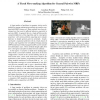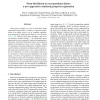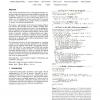133
click to vote
IJCV
2012
12 years 10 months ago
2012
The Hierarchical Conditional Random Field (HCRF) model have been successfully applied to a number of image labeling problems, including image segmentation. However, existing HCRF m...
139
click to vote
CVPR
2012
IEEE
12 years 10 months ago
2012
IEEE
A large number of problems in computer vision can be modeled as energy minimization problems in a markov random field (MRF) framework. Many methods have been developed over the y...
112
click to vote
CVPR
2012
IEEE
12 years 10 months ago
2012
IEEE
Label fusion strategies are used in multi-atlas image segmentation approaches to compute a consensus segmentation of an image, given a set of candidate segmentations produced by r...
103
click to vote
CVPR
2012
IEEE
12 years 10 months ago
2012
IEEE
Many cues have been proposed for contour detection or image segmentation. These include low-level image gradients to high-level information such as the identity of the objects in ...
109
click to vote
PAMI
2012
12 years 10 months ago
2012
—We present a novel framework to generate and rank plausible hypotheses for the spatial extent of objects in images using bottom-up computational processes and mid-level selectio...
118
click to vote
TOG
2012
12 years 10 months ago
2012
Using existing programming tools, writing high-performance image processing code requires sacrificing readability, portability, and modularity. We argue that this is a consequenc...
121
click to vote
JMLR
2012
12 years 10 months ago
2012
Models such as pairwise conditional random fields (CRFs) are extremely popular in computer vision and various other machine learning disciplines. However, they have limited expre...
388
click to vote
Dataset
Active contours, or snakes, are computer-generated curves that move within images to find object boundaries. Its 3D version is often known as deformable models or active surfaces ...
403
click to vote
Tutorial
Active contours, or snakes, are computer-generated curves that move within images to find object boundaries. Its 3D version is often known as deformable models or active surfaces ...
374
click to vote
Source Code
Active contours, or snakes, are computer-generated curves that move within images to find object boundaries. Its 3D version is often known as deformable models or active surfaces ...






